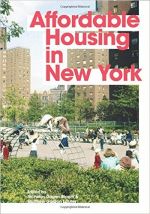Affordable Housing in New York: The People, Places, and Policies That Transformed a City

Affordable Housing in New York takes a longitudinal approach to exploring housing in New York City. Drawing upon the expertise of historians, architects, and urban planners, this book aims to tell an alternative story about below-market subsidized housing in the United States across the 20th century. According to the editors, no single title has examined this housing in New York from such a long-term and bottom-up perspective (page 12). Thus with the aim to “marshal new resources for maintenance and production of subsidized housing” for the 21st century, the book draws attention to New York City’s remarkable achievement in this area by revisiting nearly 36 projects showcasing inspiring communities, programmes and leaders (pages 11 and 13). In particular the book attends to the experience of residents and communities when assessing design outcomes and history.
Divided into six chapters, the changing patterns in New York City’s below-market housing are tracked over time using news reports and other published accounts, interviews, social data, and photographs, notably by visual sociologist David Schalliol (pages 13 and 14). Within each chapter case studies “of representative communities offer long-term analysis of their design, financing, management, and social history” and thus reveal the quality and value still found in them. In essence, the editors of this book believe that the housing question in New York needs “large-scale funding and even large-scale complexes, however out of fashion both might be”, and hope to inspire leaders and citizens to pursue these (pages 13 and 14).
Chapter 1 looks at early subsidized housing between 1926 and 1933 – in particular the reliance on philanthropic funds to provide below-market housing until the 1926 housing law launched government into the realm of public housing. Chapter 2 examines public housing between 1934 and 1941 within the context of housing built by the New York City Housing Authority (NYCHA). Turning to look at post-World War II public housing between 1948 and 1973, Chapter 3 discusses the 1949 housing act and NYCHA’s slum clearance and building, and notes how “differences between public housing in New York City and other American cities became more extreme in the postwar era” (page 113). In Chapter 4, middle-income housing between 1938 and 1973 is examined in relation to the belief of many reformers and civic leaders that “New York City ought to have below-market subsidized housing… also for moderate income families” (page 139). This covers the Federal Housing Administration’s limited-dividend programme, 1942 redevelopment companies and New York State’s Division of Housing (page 6). Chapter 5 focuses on experimental housing between 1960 and 1975, which grew out of efforts to redress the quality (rather than quantity) of below-market subsidized housing (page 193). It therefore showcases innovative and decentralized programmes and community-led redevelopment to re-envision low-income housing (page 197). To end, Chapter 6 brings us to the current time by examining the decentralized housing network between 1969 and 2014, which has its roots in the international urban crisis. Here the creation of new neighbourhood-based corporations is examined.
Book note prepared by Hannah Keren Lee
Search the Book notes database
Our Book notes database contains details and summaries of all the publications included in Book notes since 1993 - with details on how to obtain/download.
Use the search form above, or visit the Book notes landing page for more options and latest content.
For a searchable database for papers in Environment and Urbanization, go to http://eau.sagepub.com/

